내반족( 엄지 발가락 안쪽 휨증), In-toeing(Intoeing/Hallux varus)
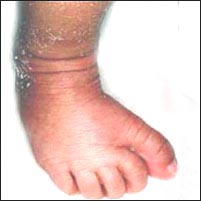
사진 104. 신생아의 발의 앞부분이 안쪽으로 구부러져서 생긴 생리적 내반족.
Copyright ⓒ 2011 John Sangwon Lee, M.D., FAAP
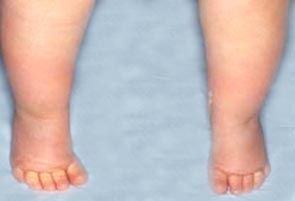
사진 105. 3개월 영아의 발의 앞부분이 안으로 구부러져서 생긴 생리적 내반족.
Copyright ⓒ 2011 John Sangwon Lee, M.D., FAAP
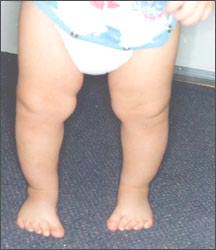
사진 106. 선천적 내전 중족골 내반족
양 발의 허리 부분이 안으로 구부러져 생긴 선천성 중족골 내반족(Congenital metatarsus varus)과 그로 인해 생긴 내반족
Copyright ⓒ 2011 John Sangwon Lee, M.D., FAAP
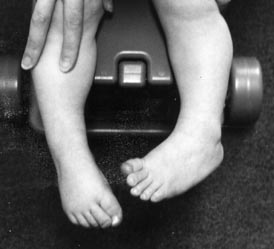
사진 107. 발과 아래 다리의 경골과 비골은 정상이지만 대퇴골 두부가 생리적으로 약간 안쪽으로 돌아간 현상을 대퇴골 두부 전경이라 한다.
생리적 대퇴골 두부 전경으로 양쪽 발에 생리적 내반족이 생겨있다. 그로 인해 양 발에 내반족이 생겼다.
Copyright ⓒ 2011 John Sangwon Lee, M.D., FAAP
- 무지(엄지 발가락)가 안쪽으로 향해 있는 발의 상태를 내반족(중족골 내반/Pigeon toe/Metatarsus varus/metatarsus adductus/in-toe gait/intoeing/in-toeing or false clubfoot)라고 한다.
- 내 반족이 있으면 안짱걸음(내족지보행,오리걸음, In Toeing Gate). 안짱걸음으로 걸을 수 있다.
- 발도 정상이고 아래 다리에 있는 경골도 비골도 정상인데 대퇴골 두부가 전경되면 내반족이 생길 수 있다.
- 대퇴골 두부와 발은 정상인데 아래 다리에 있는 경골이 안쪽으로 비틀리면 내반족이 생길 수 있다.
- 대퇴골 두부와 아래 다리에 있는 경골도 비골도 다 정상인데 발의 허리 부분이 안쪽으로 향할 때 내반족이 생길 수 있다. 이 경우 중족골 내반(증)이라 한다.
- 대퇴골과 아래 다리에 있는 경골과 발이 모두 안쪽으로 향하면 내반족이 생길 수 있다.
- 내반족이 있으면 안짱걸음(오리걸음)을 걸을 수 있다.
내반족의 원인
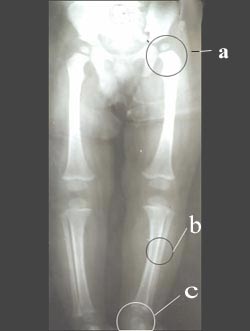
사진 108. a○-고관절과 대퇴골 두부,
b○-경골과 비골, c-○발목뼈
Copyright ⓒ 2011 John Sangwon Lee, M.D., FAAP
- 대부분의 성인들의 발의 끝부분은 앞쪽으로 곧게 향해 있던지 약간 바깥쪽을 향해 있는 것이 보통이다.
- 그러나 드물게 발의 끝부분이 안쪽으로 향해 있을 수 있다.
- 영유아들이나 학령기 아이들이 누워 있을 때, 걸을 때, 또는 서 있을 때, 한쪽이나 양쪽의 발의 끝부분의 전부 또는 엄지발가락(무지)만 몸통이 있는 안쪽으로 향해 있는 상태를 내반족이라고 한다.
- 신생아들이나 생후 2세 이전 영유아들의 한쪽 무지 또는 양쪽 무지가 안쪽으로 향해서 내반족이 생기는 것이 거의가 정상적이다.
- 이렇게 정상적으로 생기는 내반족을 생리적 내반족이라고 한다.
- 생리적 내반족의 대부분은 점차로 자라면서 저절로 없어진다.
- 드물게 내반족이 병적으로 인해 생길 수 있다. 그런 내반족을 병적 내반족이라고 한다.
내반족의 원인을 구체적으로 더 알아보자
(팔과 다리 참조).
① 좁은 자궁 속 태아는 최소한도로 작은 체적을 취하면서 자란다.
이 때 한쪽, 또는 양쪽 발의 앞부분이 몸통 안쪽으로 향할 수 있다.
이것을 태아 내반족이라고 한다.
태아의 무지에만 내반족, 즉 무지 내반족이 생길 수 있고 때로는 무지 내반족과 중족골 내반족이 함께 있을 수 있다. 어떤 때는 엄지발가락(무지)만 갈고리처럼 몸통 안쪽으로 구부러져 무지 내반족이 생길 수 있다.
② 발 전체, 발의 허리 부분, 발의 앞부분, 엄지발가락 모두가 정상이지만 두 무릎 아래에 있는 다리의 한쪽 경골 또는 양쪽 경골이 몸통의 안쪽으로 향해 비틀릴 때 발 끝부분이 덩달아 몸통 안쪽으로 향해서 내반족이 생긴다. 출생 이전 자궁 내에서 취했던 태위를 출생 이후에도 얼마동안 계속 유지하는 것이 정상적이다. 그 때문에 출생 후 18~24개월경까지 아랫다리에 생리적 O형 다리가 생길 수 있다. 아랫다리가 생리적 O형 다리로 몸통 안쪽으로 향해 구부러질 때 정상적인 발의 끝 부분이 몸통 안으로 향해 그 쪽 발에 내반족이 생길 수 있다.
내반족을 가진 영유아들의 얼굴이 바닥으로 향하게 엎드려 재우면 몸통 안쪽으로 구부러진 아랫다리의 경골이 더 안쪽으로 구부러질 수 있다.
그 때문에 이미 생긴 내반족이 몸통 안쪽으로 더 향하게 된다.
③ 발전체도 정상이고 아랫다리의 경골과 비골도 정상적으로 곧지만 한쪽, 대퇴골 두부나 양쪽 대퇴골 두부가 정상적으로 전경(대퇴전경/大腿前傾·/Femoral anteversion)될 때 그 쪽의 위 다리, 아래 다리, 발전체와 엄지발가락이 몸통 안쪽으로 향하게 되고 내반족이 생길 수 있다(사진 107 참조).
④ 중족골 내반족(증)이 있고 그 쪽 아랫다리의 경골이 몸통 안쪽 안으로 비틀렸을 때도 사진 106에서 보는 것과 같이 내반족이 생길 수 있다.
대퇴골, 경골과 발의 끝 부분이 몸통 안쪽으로 행해 뒤틀리게 하는 이상이 동시 있어도 내반족이 생길 수 있다.
표 1. 중족골 내반족증, 경골 내 틀림, 대퇴골 전경의 감별진다.
| – | 중족 내전 | 경골 내염전 | 대퇴골 전경 |
| 나타나는 연령 | 생후 4~14개월 | 생후 1~2세 | 생후 3~6세 |
| 자연적 경과 | 85%가 자연히 정상으로 된다 | 99%가 자연히 정상으로 된다 | 거의 자연히 정상으로 된다 |
| 증상 | 외관상 문제, 족통, 신발 문제 | 없다 | 때로는 미관상 문제, 때로는 무릎 통증 |
| 조기 치료 | 수동 물리치료와 캐스트치료 | 드물게 데니스 바라운 바로 치료한다 | 없음 |
| 자연 치유가 되지 않고 기형이 계속 되면 | 발뼈 수술 | 발뼈 수술 | 대퇴골 수술 |
내반족의 치료
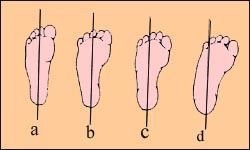
그림 109.
a-정상 발, b-경도 중족골 내반족증, c-중등도 중족골 내반족증, d-중증 중족골 내반족증
Copyright ⓒ 2011 John Sangwon Lee, M.D., FAAP
- 출생 이후 얼마 동안 대부분의 영유아들의 다리에 생리적 O형 다리도 생길 수 있고 발에 내반족도 생길 수 있다.
- 이런 생리적 내반족이나 경미한 선천성 중족골 내반족으로 생긴 대부분의 내반족은 치료를 해 주지 않아도 생후 12∼18개월이 될 때까지 자연히 치료된다.
- 그러나 심한 중족골 내반족으로 생긴 내반족은 의사의 지시에 따라 그 쪽 발을 손으로 주물러 물리 치료를 하든지, 석고 붕대 치료, 또는 특별 구두로 치료한다.
- 발 전체가 곧고 정상이지만 무릎 아래 양쪽 다리의 경골이 몸통 안쪽으로 구부러져서 생긴 대부분의 내반족은 아무런 치료를 하지 않아도 3∼5세 사이에 저절로 낫는다.
- 그렇지만 피로할 때나 무거운 신발을 신을 때는 내반족 현상이 더 심하게 나타날 수도 있다.
- 내반족이 경미하거나, 심하거나, 저절로 낫지 않거나, 점점 더 심해지면 일단 단골 소아청소년과의 소개를 받아 정형외과 전문의 자문을 받아 치료받아야 한다.

그림 110. 중족골 내반족의 85%는 자연적으로 치료되지만 자연적으로 치료가 되지 않으면
a-중족골 내반족을 손으로 수동적 물리 치료를 하든지
b-석고 붕대로 치료하든지, c-신발로 치료하든지 또는 d-데니스 브라운 바로 치료한다.
Copyright ⓒ 2011 John Sangwon Lee, M.D., FAAP
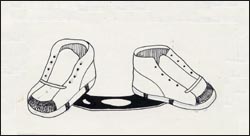
그림 111. 데니스 브라운 바
내전 중족을 데니스 브라운바로 치료하기도 한다.
Copyright ⓒ 2011 John Sangwon Lee, M.D., FAAP
- 선천성 중족골 내반족으로 내반족이 생겼을 때는 내반된 발 엄지발가락이 바깥쪽으로 향하도록 치료한다.
- 경미한 내반족은 의사의 지시에 따라 오른쪽 신발을 왼쪽 발에, 왼쪽 신발을 오른쪽 발에 신기고 재워 치료하기도 한다.
- 또는 밤에 잠자는 동안 신을 신긴 채로 양쪽 신발 뒤꿈치를 끈으로 함께 잡아매어 치료하기도 한다.
- 또는 잠옷에 달린 신발 양쪽 뒤꿈치를 바늘로 꿰맨 후 그 잠옷을 입혀 재운다. 아랫다리 경골이 심하게 몸통 안쪽으로 구부러져 내반족이 심하게 생겼으면 부목 치료를 한다.
- 정상적인 성장발육으로 생긴 대부분의 생리적 내반족은 치료 없이 저절로 낫는다.
- 특수한 구두나 브레이스 등으로 오랫동안 치료를 하기 전에 단골 소아청소년과 의사의 소개를 받아 정형외과 전문의의 진단 치료를 받아야 한다.
|
다음은 “ 걸음걸이가 좀 이상해요”에 관한 인터넷 소아청소년 건강상담 질의응답의 예 입니다. |
Q&A. 걸음걸이가 좀 이상해요
Q.
안녕하세요 .
39개월 된 남자아이를 둔 엄마입니다.
아이가 걸음걸이가 이상해서요. 걸을 때 오른쪽발만이 안쪽을 향해서 걸어요. 그래서 그런지 약간 저는 듯하게 걸음을 걷는데 어떡해야 하는지요.
세워놓고 보거나 뉘여서 보면은 다리가 휘거나 하지는 않았거든요.
가끔 엎드려서 자위행위를 하는데 그 영향인지요. 검사를 받아야 하는 건지 아니면 좀 더 지켜 봐야 하는지 궁금해서요. 검사를 받는다면 외과로 가야하나요?
A.
미순님
안녕하세요. 좋은 질문을 해주셔서 감사합니다. 자녀의 나이, 성별, 과거 병력, 가족 병력, 진찰소견, 임상검사 등 자세한 정보가 더 많이 있을수록 더 좋은 답변을 드릴 수 있지만 주신 정보를 토대로 답변을 드리겠습니다.
발가락뼈, 발 앞부분, 발 중간 부분(발 허리), 발 뒷부분, 경골, 대퇴골, 고관절 중 일부, 또는 전체에 어떤 이상이 있을 때 발끝이 몸통 안쪽을 향해서 걸을 수 있습니다.
발의 중간 부분도 발의 다른 부위도 정상이지만 엄지발가락이 있는 발의 앞부분만 안쪽을 향해서 휘어졌을 때 그 발은 몸통 안쪽을 향해서 걷게 됩니다.
발가락도 정상이고 다리도 정상이지만 발의 앞부분이 안쪽으로 휘어지면 안쪽을 향해서 걷게 됩니다.
발가락도 발의 앞부분도 정상이고 다리도 정상이지만 발의 허리 부분이 몸통 안쪽으로 굽거나 발의 뒷부분이 뒤쪽으로 향해 걸을 때 발 끝부분이 안으로 향해 걸을 수 있습니다.
발도 정상이고 발가락도 정상이고 발 뒷부분도 정상인데 경골이 안쪽으로 휘어지면 발끝이 안쪽으로 향해 걸을 수 있습니다.
발도 경골도 정상이지만 대퇴골이 안으로 휘어지면 발가락을 안쪽으로 향해 걸을 수 있습니다.
발, 경골, 대퇴골도 정상이지만 고관절에서 대퇴골 두부가 안쪽으로 향해 있을 때 발을 안쪽으로 향해서 걸을 수 있습니다.
발끝 부분이 안쪽으로 굽는 현상은 선천성 원인, 후천성 원인, 또 다른 여러 종류의 질환 내지 생리적 현상으로 생길 수 있습니다.
좀 복잡한 설명이지만 발을 안으로 향해 걸을 때는 정상적으로 생기는 생리적 내반족도 있고 병적으로도 생길 수 있는 병적 내반족도 있습니다.
일반적으로 단골 소아 청소년과에 가서 거기서 해결할 수 없는 내반족이면 단골 소아청소년과의 소개를 받아 소아 정형외과 전문의나 일반 정형외과 전문의의 도움을 받으십시오.
수음을 하는 것은 정상적이고 그로 인해서 발에 그런 현상이 생기는 것은 아닙니다.
내반족을 참조하시기 바랍니다. 질문이 더 있으시면 다시 연락 주시기 바랍니다.
감사합니다.
|
다음은 “내반지 그리고 잘 넘어져요”에 관한 인터넷 소아청소년 건강상담 질의응답의 예 입니다. |
Q&A. 내반지 그리고 잘 넘어져요
Q.
안녕하세요, 선생님.
다름이 아니라 이제 17개월 된 남자아이예요. 집안에서 이제는 좀 걷는다고 뛰어다니기 시작합니다. 그런데 자주 넘어져요. 왜 그런가 하고 보니 제가 보기엔 엄지 발가락이 안으로 접혀서 거기에 걸려서 넘어 지는 것 같아 보여요. (방바닥을 향해 안으로 입니다. ^ㅡ^) 엄지 발가락이 이상한 걸까요? 아니면 아직 어리고 서툴러서 그런 걸까요? 양말을 신기면 괜찮을까요?
그럼 좋은 답변을 부탁드립니다.
A.
조원님
안녕하세요. 좋은 질문해 주셔서 감사합니다.
자녀의 나이, 성별, 과거 병력, 가족 병력, 진찰소견, 임상검사 등의 정보를 더 많이 알수록 답변을 드리는데 도움이 됩니다. 주신 정보를 토대로 해서 답변을 드리겠습니다. 질문에 대해서 확실히 이해할 수 없습니다. 죄송합니다.
엄지발가락이 몸통이 있는 안쪽으로 향하는 상태를 내반족증이라고 합니다. p.00 내반족을 참조하시기 바랍니다.
태어나서 성인이 될 때까지 아이들은 계속 성장 발육합니다.
그 성장 발육과정을 일부 살펴보면, 신체의 여러 계통의 여러 기관 중 머리와 상체의 기능이 제일 먼저 발육되고 하체와 발의 기능이 제일 늦게 발육됩니다.
다시 말씀드리면, 출생 후 바로 머리(중추 신경계)와 얼굴에 있는 눈이라든지 귀 입 코 등기관의 기능은 비교적 이미 많이 발육되었습니다.
머리와 얼굴에 있는 각 기관의 기능은 어느 정도 잘 발육되어 있다. 그러나 특히 첫 돌 이전, 서고 걸을 수 있는 다리발의 발육은 상체의 발육보다 더 서서히 발육 되는 것이 정상입니다.
다시 말씀드리면, 6~7개월 된 영아들은 우유병을 손으로 잡고 혼자서 먹을 수 있을 정도로 상지와 손의 발육이 잘 발육되어 있지만 혼자 설 수 있을 정도로 발과 다리는 잘 발육되어 있지 않습니다.
또 아장아장 걷기 시작하는 2~3세 된 유아들은 다리와 발로 성숙하게 걸을 수 있게 발육되어 있지 않습니다.
이 때 대부분의 유아들의 손 발 몸통 다리 등이 잘 조화 있게 운동할 수 있을 정도로 잘 발육되어 있지 않은 것이 정상입니다. 그 때문에 아장아장 걷기 시작하는 유아들의 대부분은 잘 넘어지는 것이 보통입니다.
선천성으로 발의 앞부분, 발의 중간 부분이나 발전체, 경골 또는 고관절에 있는 대퇴골 등이 몸통 안쪽으로 향할 때 내반족이 생길 수 있습니다.
대부분의 경우, 내반족은 생리적으로 생깁니다.
생리적으로 생긴 내반족을 생리적 내반족이라고 합니다.
생리적 내반족이 있다고 해서 잘 넘어지지는 않습니다.
그러나 무지, 발, 아래다리, 고관절 등에 있는 선천성 기형으로 내반족이 생길 수 있습니다. 이런 경우, 잘 넘어질 수 있습니다. 이경우, 그 문제를 적절히 치료해야 합니다.
소아청소년과에서 검진 진단 치료를 받고 상담하시기 바랍니다.
내반족과 무지내반. [부모도 반의사가 되어야 한다– 소아가정간호백과]-제 3권 신생아, 영유아, 학령기 아이 사춘기 아이 성장발육–해당 연령의 성장 발육.
제 2권 소아청소년 질병 및 안전사고 예방–정기 건강검진 등을 참조하시기 바랍니다.
질문이 더 있으시면 다시 연락 주세요. 감사합니다
|
다음은 “내반지”에 관한 인터넷 소아청소년 건강상담 질의응답의 예 입니다. |
Q&A. 내반지
Q.
저희 아이는 36개월 남아입니다.
걸음을 15개월에 걸었고요. 걸음을 걸을 때 보면 팔자로 걸음을 걷습니다. 다리는 좀 가는 편이고요. 잘 넘어지고요. 다리에 힘도 없고 약간 휜 것 같아 병원에 가서 검사 받았는데 정상이라네요. 팔자걸음을 정상적으로 걸을 수 있게 집에서 도와줄 수 있는 방법을 알려 주세요. 바른 자세로 앉게 하고 다리운동은 자주 시켜주고 있습니다.
A.
초보님께
안녕하세요. 질문해 주셔서 감사합니다. 좋은 질문입니다. 자녀의 나이, 성별, 과거 병력, 가족 병력, 진찰소견, 임상검사 등의 정보를 더 많이 알수록 답변을 드리는데 도움이 됩니다. 주신 정보를 토대로 해서 답변을 드리겠습니다.
팔자걸음이란 양쪽 엄지발가락이 몸통의 양쪽 밖으로 향하게 걷는 증상인지, 그렇지 않으면 양쪽 엄지발가락이 몸통 상하 중앙 종선을 향하게 걷는 증상인지 확실히 모르겠습니다.
단골 소아청소년과에서 검진 받으시고 문의하시기 바랍니다.
무지외반과 내반족에 관한 정보가 있으니 참조하시고 질문이 더 있으시면 연락해 주십시오.
자연 섭리에 따라 성장 발육하도록 양육하는 것이 좋은 때가 많습니다.
요즘 영아들에게 마사지를 해주는 것이 대 유행인 것 같습니다.
저는 그것 권장하고 싶지 않습니다.
말로 자기의 의사를 제대로 표현할 수 없는 영아들의 뼈, 건, 인대와 근육 등을 너무 세게 당기거나 밀거나 비틀고 눌러서 수동적 마사지를 오랫동안 과다하게 하는 것은 영아들에게 해가 될 수 있습니다.
또 그렇게 하는 대부분의 경우, 어른들이 좋아서 하는 것이지 영아들이 좋아서 해주는 것이 아닙니다.
하여튼 이런 영유아 마사지 유행은 지쳐서 그만두거나 부작용이 생겨 그만 둘 때까지 계속될 것입니다.
마사지를 해줄 때 신체적 접촉 사랑을 해주는 것은 좋을 수 있습니다.
아직도 문제가 있으면 소아청소년과에서 진찰 진단을 받으시고 이 문제에 대해서 상담하시기 바랍니다. p.00 내반족, 무지외반 등을 참조하시기 바랍니다.
질문이 더 있으면 다시 연락해 주시기 바랍니다. 감사합니다.
|
다음은 “내반지”에 관한 인터넷 소아청소년 건강상담 질의응답의 예 입니다. |
Q&A. 내반지
Q.
안녕하세요…
저는 16개월된 딸아의 맘입니다..
9~10개월 정도부터 걷기 시작했는데 아이가 자꾸 안쪽으로 걷고 심지어는 앉아 있을때도 발이 안쪽으로 모아집니다… 아이의 아빠는 그렇지 않은데 시어머니를 비롯한 여자들이 모두 안쪽으로 걷는 것 같아요 이런 유전적인 성향에서도 교정이 가능한지 알려주세요…
A.
형수님께
안녕하세요. 질문해 주셔서 감사합니다. 좋은 질문입니다.
자녀의 나이, 성별, 과거 병력, 가족 병력, 진찰소견, 임상검사 등의 정보를 많이 알수록 답변을 드리는데 도움이 됩니다.
주신 정보를 토대로 해서 답변을 드리겠습니다.
좋은 질문을 하셨는데 집안 친 부모 형제들의 일부가 거의 같은 상태로 걷기 때문에 유전성 성향이 있는지 의심해 봅니다.
그러나 어떤 병으로 그렇게 걷는지 또는 생리적으로 그렇게 걷는지 확실히 알 수 없습니다.
치료하면 고칠 수 있는 어떤 건강 문제를 적기에 적절히 치료하지 않고 치료 적기를 잃어버리면 때로는 더 이상 치료할 수도 없고 일생 장애자가 될 수도 있습니다.
고관절에 있는 대퇴골 두부가 안쪽으로 전향되거나 대퇴골이 안 쪽으로 굽거나 아랫다리에 있는 경골이 몸통 안쪽으로 휘거나 또는 발 중간 허리가 몸통 안쪽으로 휘거나 발의 앞 부분만 몸통 안쪽으로 향하거나 이상 여러 가지 원인들 중 1~2가지나 그 이상에 문제가 생길 때 발이 몸통 안쪽으로 향 할 수 있고 안짱걸음을 걸을 수 있습니다.
우선 소아청소년과에서 진찰 진단을 받으시고 이 문제에 관해서 상담하시기 바랍니다.
O형 다리와 X형 다리, 무지 내반을 참조하시기 바랍니다.
질문이 더 있으시면 다시 연락 주시기 바랍니다. 감사합니다.
In-toeing (Intoeing/Hallux varus)

Picture 104. Physiological varus foot caused by an inward flexion of the anterior part of the foot of a newborn baby. Copyright ⓒ 2011 John Sangwon Lee, M.D., FAAP

Picture 105. Physiological varus of a 3-month-old infant caused by an inward flexion of the anterior part of the foot. Copyright ⓒ 2011 John Sangwon Lee, M.D., FAAP

Picture 106. Congenital adduction metatarsal varus Congenital metatarsus varus caused by an inward bending of the lumbar region of both feet and resulting varus Copyright ⓒ 2011 John Sangwon Lee, M.D., FAAP

Photo 107. A phenomenon in which the tibia and fibula of the foot and lower leg are normal, but the femoral head is physiologically turned slightly inward is called anterior femoral head. Physiological frontal femoral head with physiological varus in both feet. As a result, I developed varus in both feet. Copyright ⓒ 2011 John Sangwon Lee, M.D., FAAP
• The condition of the foot with the thumb (big toe) facing inward is called varus (metatarsus varus/metatarsus adductus/in-toe gait/intoeing/in-toeing or false clubfoot).
• If I have half-legged, I will walk without (inner toe, duck, In Toeing Gate).
You can walk with a slow gait. • If the foot is normal and the tibia and fibula in the lower leg are also normal, but the femur head is forward, a varus may occur.
• The head and foot of the femur are normal, but if the tibia in the lower leg is twisted inward, a varus can occur.
• The tibia and fibula in the head of the femur and the lower leg are all normal, but when the lower back of the foot turns inward, a varus may occur. In this case, it is called metatarsal varus (inflammation).
• If both the tibia and the foot in the femur and lower leg are turned inward, a varus can occur. • If you have a valgus, you can walk with a duck gait (duck gait).
Causes

Picture 108. a○-hip joint and femur head, b○-tibia and fibula, c-○ankle bone Copyright ⓒ 2011 John Sangwon Lee, M.D., FAAP
• For most adults, the tip of the foot is usually straight forward or slightly outward. • Rarely, however, the tip of the foot may be turned inward.
• In infants and school-age children, when lying, walking, or standing, all of the tips of one or both feet or the big toe (middle toe) faces inward with the torso is called varus foot. • In newborns and children before the age of 2 years, it is almost normal for one or both thumbs to point inward, resulting in valgus.
• This normally occurring varus is called physiological varus.
• Most of the physiological varus goes away on their own as they grow older.
• Rarely, varus foot can be caused by pathology. Such hallmarks are called pathological hallmarks.
Let’s take a closer look at the causes
① The fetus in the narrow womb grows while taking the smallest volume. At this time, the
front part of one or both feet may face inward to the torso. This is called fetal hallux. Only the ignorance of the fetus can develop ignorance, sometimes ignorant, and sometimes both ignorant and metatarsal varus. Sometimes, only the big toe (the thumb) is bent inside the torso like a hook, which can lead to a big toe.
② The whole foot, the waist part of the foot, the front part of the foot, and the big toe are all normal, but when one tibia or both tibias of the leg below the two knees are twisted toward the inside of the torso, the tip of the toe turns toward the inside of the torso at the same time, causing a varus occurs It is normal to maintain the position taken in the womb before birth for some time after birth. As a result, physiological O-legs can develop in the lower leg by around 18 to 24 months after birth. When the lower leg is bent toward the inside of the torso with a physiological O-leg, the tip of the normal foot points into the torso, resulting in a varus foot on that side. When infants and toddlers with valgus are put to sleep with their face facing down, the tibia of the lower leg, which is bent inward of the torso, can be bent further inward. As a result, the already formed varus is directed more towards the inside of the torso.
③ The development body is normal and the tibia and fibula of the lower leg are normally straight, but when one or both femoral heads or both femoral heads are in a normal foreground (anterior view of the femur), the upper leg and lower leg The developing body and the big toe are directed inward of the torso, and a varus foot may develop (see photo 107).
④ If there is a metatarsal varus (inflammation) and the tibia of the lower leg is twisted into the inside of the torso, as shown in photo 106, varus foot may also occur. Even if there is an abnormality that causes the femur, tibia, and tip of the foot to twist inward of the torso at the same time, varus foot can occur.
Table 1. Differentiation of metatarsal valgus, tibialis anterior, and anterior femur.
표 1. 중족골 내반족증, 경골 내 틀림, 대퇴골 전경의 감별진다.
| – | 중족 내전 metatarsal valgus | 경골 내염전
tibialis anterior |
대퇴골 전경
anterior femur. |
| 나타나는 연령 age of appearance | 생후 4~14개월 4 to 14 months old | 생후 1~2세 1 to 2 years old | 생후 3~6세 3 to 6 years old |
| 자연적 경과 natural course | 85%가 자연히 정상으로 된다. 85% become normal naturally | 99%가 자연히 정상으로 된다. 99% will naturally become normal | 거의 자연히 정상으로 된다.almost naturally normal |
| 증상 symptoms | 외관상 문제, 족통, 신발 문제 Appearance problems, foot pain, shoe problems | 없다. none | 때로는 미관상 문제, 때로는 무릎 통증 Sometimes cosmetic problems, sometimes knee pain |
| 조기 치료 early treatment | 수동 물리치료와 캐스트치료 Manual physical therapy and cast therapy | 드물게 데니스 바라운 바로 치료한다. Rarely treated with Dennis Baraun bar | 없음 none |
| 자연 치유가 되지 않고 기형이 계속 되면 If the deformity continues without natural healing | 발뼈 수술 foot bone surgery | 발뼈 수술 foot bone surgery | 대퇴골 수술 femur surgery |
Femur surgery treatment

Figure 109. a-Normal foot, b-Mild metatarsal varus foot, c-Moderate metatarsal varus foot, d-Severe metatarsal variofoot. Copyright ⓒ 2011 John Sangwon Lee, M.D., FAAP
• For some time after birth, most infants and toddlers may develop a physiological type O leg in the leg, as well as varus in the foot.
• Most of these physiological varus or minor congenital metatarsal varus will heal spontaneously by 12 to 18 months of age without treatment. • However, as a result of severe metatarsal varus foot, according to the doctor’s instructions, physical therapy by hand rubbing the foot, plaster bandage treatment, or special oral treatment.
• Although the entire foot is straight and normal, most of the varus feet caused by bending the tibia of both legs below the knee into the inside of the body will heal spontaneously between 3 and 5 years of age without any treatment.
• However, when you are tired or when you wear heavy shoes, you may have more severe varus.
• If the clubfoot is mild, severe, does not heal on its own, or gets progressively worse, you should first be referred to a regular pediatrician and consult an orthopedic specialist for treatment.

Figure 110. 85% of metatarsal varus can heal spontaneously, but if not treated spontaneously a – Manual physical therapy for metatarsal varus Treat with b-plaster bandages, c-shoes or d-dennis brown bars. Copyright ⓒ 2011 John Sangwon Lee, M.D., FAAP

Figure 111. Dennis Brown Bar He also treats the midfoot of civil war with Dennis Brownbar. Copyright ⓒ 2011 John Sangwon Lee, M.D., FAAP
• In case of congenital metatarsal varus foot, treat with the big toe facing outward.
• Mild varus foot may be treated by putting the right shoe on the left foot and the left shoe on the right foot according to the doctor’s instructions.
• Alternatively, while you sleep at night, the heels of both shoes are tied together with laces while you sleep.
• Or, sew both heels of the shoes attached to the pajamas with a needle and put them on the pajamas to sleep. If the lower leg tibia is severely bent to the inside of the torso, resulting in severe varus, splint treatment is required.
• Most physiological varus resulting from normal growth and development will resolve spontaneously without treatment.
• Before long-term treatment with special shoes or braces, you should receive a referral from a regular pediatrician and receive diagnostic treatment from an orthopedic surgeon.
The following is an example of a Q&A on health counseling for children and adolescents on the Internet about “Your gait is a bit strange”.
Q&A. My gait is a bit strange
Q. Hello . I am a mother of a 39 month old boy. The child’s gait is strange. When walking, only her right foot is facing inward.
That’s why I’m walking like a little limp, what should I do? The legs did not bend when viewed standing up or lying down. Sometimes I masturbate on my stomach, maybe that’s the effect? I was wondering if I should get tested or if I should wait a little longer. Should she go to the surgeon if she gets tested?
A. Miss Soon Hello. Thanks for asking a good question. The more detailed information such as the child’s age, gender, past medical history, family history, examination findings, and clinical examination, the better we can give you an answer, but we will give you an answer based on the information you have given us. If there is something wrong with any or all of the toe bones, the forefoot, the midfoot (lower back of the foot), the back of the foot, the tibia, the femur, or the hip joint, you may be able to walk with your toes pointing inward. The middle part of the foot and other parts of the foot are also normal, but when only the front part of the foot with the big toe is bent inward, the foot is walking toward the inside of the torso.
The toes are normal and the legs are normal, but when the front of the foot curves inward, the person walks inward.
The toes and the front of the foot are normal, and the legs are normal, but when the back of the foot curves inward to the torso or the back of the foot turns backwards, the tip of the foot may walk inward. If your feet are normal, your toes are normal, your back is normal, and your tibia is curved inward, you can walk with your toes pointing inward. The foot and tibia are normal, but when the femur is bent inward, you can walk with your toes inward. The foot, tibia, and femur are also normal, but can walk with the foot inward when the head of the femur is inward at the hip joint. Inward bending of the toes can be caused by congenital causes, acquired causes, other various diseases, or physiological phenomena. Although the explanation is a bit complicated, there are physiological varus that occur normally when the foot is turned inward, and there are pathological varus that can also occur pathologically. In general, go to a regular pediatrician and if you have a valgus that cannot be resolved there, get a referral to a regular pediatrician and get help from a pediatric orthopedic specialist or general orthopedic specialist. Masturbating is normal and does not cause your feet to feel like that. Please see clans. If you have any more questions, please feel free to contact us again. thank you.
The following is an example of a Q&A on health counseling for children and adolescents on the Internet about “My ring and I fall well”.
Q&A. My ring and I fall well
Q. Hi Sir. It’s no different, he’s a 17-month-old boy. Now, in the house, I start to run and walk a little. But he often falls. I wonder why, and it looks to me like the big toe is folded inward and it trips over it. (It is inward toward the floor. ^ㅡ^) Is the big toe weird? Or is it because I’m still young and clumsy? Is it ok to wear socks? So please give me a good answer.
A. Jo Won-nim Hello.
Thanks for the nice question. The more information you have, such as your child’s age, gender, past medical history, family history, examination findings, and clinical tests, the more information you have, the more helpful it will be to give you an answer. We will give you an answer based on the information you provided. I don’t quite understand your question. Sorry.
A condition in which the big toe points inward toward the torso is called varus foot. Please refer to p.00 varus foot. From birth to adulthood, children continue to grow and develop. Looking at some of the growth and development process, the functions of the head and upper body develop first, and the functions of the lower body and feet develop last among the various organs of the body. In other words, right after birth, the functions of the head (central nervous system) and the eyes, ears, mouth, nose, and etc. on the face have already been relatively developed.
The functions of each organ in the head and face are somewhat well developed. However, especially before the first stone, it is normal for the development of standing and walking legs and feet to develop more slowly than the development of the upper body. In other words, 6-7 month old infants have well developed upper extremities and hands enough to hold a bottle of milk and eat on their own, but their feet and legs are not well developed enough to stand on their own. Also, toddlers aged 2-3 years, who start toggling, are not developed to walk maturely on their legs and feet.
At this time, it is normal that most infants’ hands, feet, trunks, and legs are not well developed enough to exercise harmoniously. For this reason, it is common for most infants who start toddlers to fall easily. Congenitally, varus foot can occur when the front part of the foot, the middle part of the foot, or developmental body, or the femur in the tibia or hip joint turns inward to the torso. In most cases, valgus occurs physiologically. Physiologically occurring varus is called physiological varus.Having a physiological clubfoot doesn’t make you fall easily. However, congenital anomalies in the thumb, foot, lower leg, hip, etc. can cause varus foot. In this case, you can easily fall over. In this case, the problem must be treated appropriately.
Please consult with the Department of Pediatrics for diagnosis, diagnosis and treatment. Innervate and ignorant invar.
www.drleepediatrics.com-Vol. 3 Newborns, Infants, School-age Children, Adolescent Children Growth and Development-The growth and development of the relevant age. Please refer to Volume 2, Prevention of Diseases and Safety Accidents in Children and Adolescents-Regular Health Checkups, etc. If you have any more questions, please contact us again. thank you
The following is an example of an Internet pediatric health consultation Q&A regarding “inner ring”.
Q&A. inner ring
Q. My son is 36 months old. I walked at 15 months. When you walk, you can see that you are walking with eight arms. The legs are a bit thin. falls well. I have no strength in my legs and I think they are slightly bent, so I went to the hospital and had an examination, and it was normal. Please tell me how I can help at home to walk normally. Sit in an upright posture and exercise your legs frequently.
A. for beginners Hello. Thanks for asking.
That’s a good question. The more information you have, such as your child’s age, gender, past medical history, family history, examination findings, and clinical tests, the more information you have, the more helpful it will be to give you an answer. We will give you an answer based on the information you provided. I am not sure whether the nasolabial gait is a symptom of walking with both big toes facing out on both sides of the torso, or walking with both big toes facing the upper and lower center vertical lines of the torso. Please inquire at the regular Pediatrics Department. Please see information about hallux hallux and hallux, and contact us if you have any further questions.
There are many times when it is good to nurture children to grow and develop according to the laws of nature. It seems to be very popular these days to give massages to infants. I don’t want to recommend it. Infants who are unable to express themselves in words, excessively pulling, pushing, twisting, or pressing too hard on bones, tendons, ligaments and muscles for a long period of time can be harmful to infants. And most of the time, adults do it because they like it, not because they like it. In any case, this trend of infant massage will continue until it is exhausted or stopped due to side effects. Physical touch love can be good when giving a massage. If there is still a problem, please consult a pediatrician for a diagnosis and discuss this problem. Please refer to p.00 valgus, hallux valgus, etc. If you have any more questions, please contact us again. thank you.
The following is an example of an Internet pediatric health consultation Q&A regarding “inner ring”.
Q&A. inner ring
Q. Hello… I am the mother of a 16 month old daughter. I started walking at about 9-10 months, and the child keeps walking inward and even when sitting, the feet are gathered inward… The father of the child is not like that, but the mother-in-law and all the women seem to walk inward. Please let me know if this is possible…
A. to my brother Hello. Thanks for asking. That’s a good question. The more information you know about your child’s age, gender, past medical history, family history, examination findings, and clinical tests, the more helpful it is to give you an answer. We will give you an answer based on the information you provided. You’ve asked a good question, but I suspect that you have a hereditary predisposition, as some of your biological parents and siblings walk in about the same condition. However, it is not clear with what disease it walks like that or physiologically it walks like that. If some health problem that can be cured with treatment is not properly treated in a timely manner and is lost on time, sometimes it can no longer be treated and can become a lifelong disability. The head of the femur in the hip joint is turned inward, the femur is bent inward, the tibia in the lower leg is curved in the trunk, the waist in the middle of the foot is curved in the trunk, only the front part of the foot turns inward, etc. Various causes When one or two or more of them have problems, the feet may turn inward and the gait may be slow. First of all, please get a diagnosis from the Department of Pediatrics and consult about this problem. Please refer to O-legs and X-legs, varus plain. If you have any more questions, please feel free to contact us again. thank you.
출처 및 참조 문헌 Sources and references
- NelsonTextbook of Pediatrics 22ND Ed
- The Harriet Lane Handbook 22ND Ed
- Growth and development of the children
- Red Book 32nd Ed 2021-2024
- Neonatal Resuscitation, American Academy Pediatrics
- www.drleepediatrics.com 제1권 소아청소년 응급 의료
- www.drleepediatrics.com 제2권 소아청소년 예방
- www.drleepediatrics.com 제3권 소아청소년 성장 발육 육아
- www.drleepediatrics.com 제4권 모유,모유수유, 이유
- www.drleepediatrics.com 제5권 인공영양, 우유, 이유식, 비타민, 미네랄, 단백질, 탄수화물, 지방
- www.drleepediatrics.com 제6권 신생아 성장 발육 육아 질병
- www.drleepediatrics.com제7권 소아청소년 감염병
- www.drleepediatrics.com제8권 소아청소년 호흡기 질환
- www.drleepediatrics.com제9권 소아청소년 소화기 질환
- www.drleepediatrics.com제10권. 소아청소년 신장 비뇨 생식기 질환
- www.drleepediatrics.com제11권. 소아청소년 심장 혈관계 질환
- www.drleepediatrics.com제12권. 소아청소년 신경 정신 질환, 행동 수면 문제
- www.drleepediatrics.com제13권. 소아청소년 혈액, 림프, 종양 질환
- www.drleepediatrics.com제14권. 소아청소년 내분비, 유전, 염색체, 대사, 희귀병
- www.drleepediatrics.com제15권. 소아청소년 알레르기, 자가 면역질환
- www.drleepediatrics.com제16권. 소아청소년 정형외과 질환
- www.drleepediatrics.com제17권. 소아청소년 피부 질환
- www.drleepediatrics.com제18권. 소아청소년 이비인후(귀 코 인두 후두) 질환
- www.drleepediatrics.com제19권. 소아청소년 안과 (눈)질환
- www.drleepediatrics.com 제20권 소아청소년 이 (치아)질환
- www.drleepediatrics.com 제21권 소아청소년 가정 학교 간호
- www.drleepediatrics.com 제22권 아들 딸 이렇게 사랑해 키우세요
- www.drleepediatrics.com 제23권 사춘기 아이들의 성장 발육 질병
- www.drleepediatrics.com 제24권 소아청소년 성교육
- www.drleepediatrics.com 제25권 임신, 분만, 출산, 신생아 돌보기
- Red book 29th-31st edition 2021
- Nelson Text Book of Pediatrics 19th- 21st Edition
- The Johns Hopkins Hospital, The Harriet Lane Handbook, 22nd edition
- 응급환자관리 정담미디어
- Pediatric Nutritional Handbook American Academy of Pediatrics
- 소아가정간호백과–부모도 반의사가 되어야 한다, 이상원 저
- The pregnancy Bible. By Joan stone, MD. Keith Eddleman, MD
- Neonatology Jeffrey J. Pomerance, C. Joan Richardson
- Preparation for Birth. Beverly Savage and Dianna Smith
- 임신에서 신생아 돌보기까지. 이상원
- Breastfeeding. by Ruth Lawrence and Robert Lawrence
- Sources and references on Growth, Development, Cares, and Diseases of Newborn Infants
- Emergency Medical Service for Children, By Ross Lab. May 1989. p.10
- Emergency care, Harvey Grant and Robert Murray
- Emergency Care Transportation of Sick and Injured American Academy of Orthopaedic Surgeons
- Emergency Pediatrics A Guide to Ambulatory Care, Roger M. Barkin, Peter Rosen
- Quick Reference To Pediatric Emergencies, Delmer J. Pascoe, M.D., Moses Grossman, M.D. with 26 contributors
- Neonatal resuscitation Ameican academy of pediatrics
- Pediatric Nutritional Handbook American Academy of Pediatrics
- Pediatric Resuscitation Pediatric Clinics of North America, Stephen M. Schexnayder, M.D.
-
Pediatric Critical Care, Pediatric Clinics of North America, James P. Orlowski, M.D.
-
Preparation for Birth. Beverly Savage and Dianna Smith
-
Infectious disease of children, Saul Krugman, Samuel L Katz, Ann A.
- 제4권 모유, 모유수유, 이유 참조문헌 및 출처
- 제5권 인공영양, 우유, 이유, 비타민, 단백질, 지방 탄수 화물 참조문헌 및 출처
- 제6권 신생아 성장발육 양호 질병 참조문헌 및 출처
- 소아과학 대한교과서
Copyright ⓒ 2014 John Sangwon Lee, MD., FAAP
“부모도 반의사가 되어야 한다”-내용은 여러분들의 의사로부터 얻은 정보와 진료를 대신할 수 없습니다.
“The information contained in this publication should not be used as a substitute for the medical care and advice of your doctor. There may be variations in treatment that your doctor may recommend based on individual facts and circumstances.
“Parental education is the best medicine.